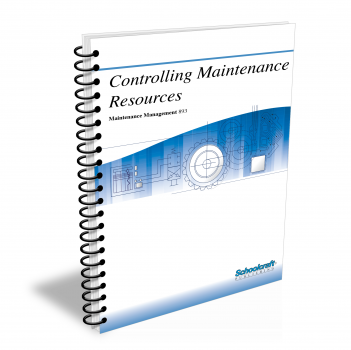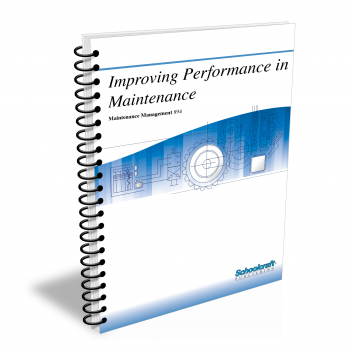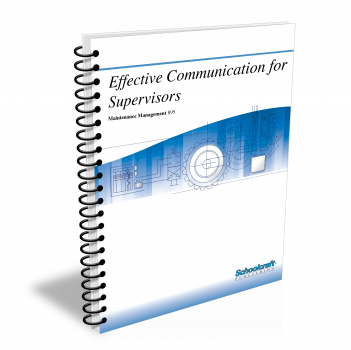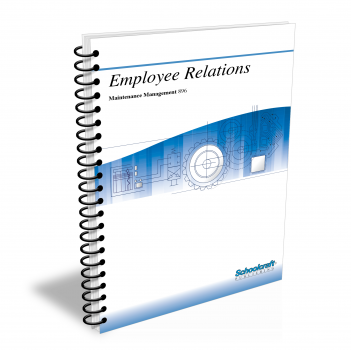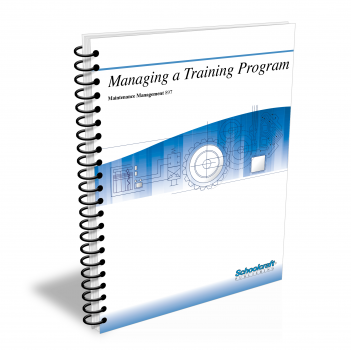Maintenance Organization
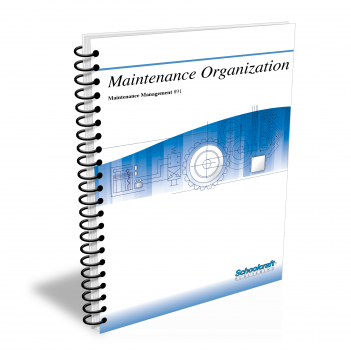
Course Number: 891
The Maintenance Organization textbook covers the basic types of maintenance organizations. Discusses cost-saving concepts of using work order systems. Explains how to develop and use information sources to implement maintenance management. Shows how to apply work standards and planning procedures to simplify a supervisor’s job. Introduces the use of computers for first-line supervisors.
Does your curriculum require additional topics not included in this textbook? Build a customized version of the Maintenance Organization textbook below.
Recommended Contact Hours – 10
Preview a Chapter
Available Supporting Material
- Table of Contents
- Exam Copies
- Suggested Titles
Table of Contents
Chapter 1: Types of Maintenance Organization
Topics: Maintenance management; Objectives and priorities; Performing effectively Overcoming maintenance problems; Types of maintenance organizations; Comparing organizations; Who controls maintenance?; Span of control; Using organizational charts; Department changes
Learning Objectives:
- Describe the functions of the first-line supervisor, the middle-level supervisor, and the top-level supervisor.
- List some of the common problems that lead to difficulties in operating a maintenance department.
- Outline the differences among functional organizations, area organizations, and the centrally controlled maintenance organization.
- Explain the chain of command of a company using its organizational chart.
- Identify the elements that make employees resistant to reorganization, and what can be done to counter this resistance.
Chapter 2: Maintenance Planning and Operations
Topics: Maintenance management system; Defining the workload; Maintenance vocabulary
Learning Objectives:
- Describe the way the first-line supervisor's position fits into the overall maintenance system.
- List five types of written orders that can be used for assigning work.
- Classify different kinds of repairs and list them in proper order of importance.
- List the duties of the maintenance planner and the maintenance engineer as they relate to the duties of the first-line supervisor.
- Define standard terms of the maintenance supervisor's vocabulary.
Chapter 3: Work Order Systems
Topics: Work orders; Controlling costs with work standards; Other system components; When to use the EWO or MWO; MWO format; Reporting resource use; Standing work orders; Equipment master file; Planner's use of the MWO; Function of the EWO; PM work orders; Manual work orders; Master schedule as a work order
Learning Objectives:
- Describe the use of the maintenance work order.
- Explain the importance of job priorities.
- Identify two basic types of work standards.
- Distinguish between the uses of the engineering work order and the maintenance work order.
- Describe the uses of the master schedule and the PM work order
Chapter 4: Using Information Sources
Topics: The uses of maintenance information; Controlling maintenance through information; Controlling labor uses and costs; The computer-based management system; Labor control information; Reporting labor information; Controlling major jobs; Material control; Maintenance costs; Non-computer information; Informal information; Performance information you've always wanted to have; Supervisors need information; Improving the information environment
Learning Objectives:
- Explain the importance if using information sources.
- List the types of information that originate within the maintenance department and from other sources.
- List the elements that must be considered when developing a computer-based information system.
- Describe the uses of labor control information.
- Calculate manhour performances indexes.
Chapter 5: Controlling Backlog through Planning
Topics: Why is maintenance planning important?; Planning as a maintenance management tool; Planning concepts; Coordinating the plan; Detailed maintenance planning procedures; Plan for craft skills; Special planning considerations; Sources of planned work; Effect of planning on manpower use
Learning Objectives:
- Explain the role planning plays in reducing downtime costs and improving manpower use.
- List the five steps of the decision-making process.
- Define goals, objectives, policies, procedures, and programs in the context of maintenance planning.
- Describe the role of the maintenance planner.
- List six areas in which planning enhances labor use.
Chapter 6: Applying Work Standards
Topics: Why use standards?; Time standards; How are time standards used?; Standards help to reduce costs; Using engineered performance standards; The spreadsheet; Controlling the backlog; Assigning priorities; Scheduling work; Craft use and backlog; Analyzing backlog data
Learning Objectives:
- Explain why standards are used.
- Describe quality and quantity standards and their uses.
- List five conditions a maintenance department must meet in order for standards to be workable.
- Describe how different types of standards are developed.
- State how the backlog can be analyzed to evaluate the makeup of the workforce.
Chapter 7: Managing Maintenance by Computer
Topics: The computer's function; Information sources; Computer files; Processing data; Sources of data-processing support; Package programs; Accessing and inputting information; Computerizing essential maintenance information; Making use of computer information
Learning Objectives:
- Describe the function of the computer in maintenance information management.
- List the types of information that should be stored in a computer.
- List types of data processing support available to maintenance departments.
- Use basic computer terminology.
Request Exam Copies
Exam Copies
Ready to see a copy of our textbooks? After selecting which textbooks you’d like to review for your course, you can submit your request by either logging in or creating an account so we know where to ship your exam copies. A representative from Schoolcraft will contact you to confirm and finish processing your request.
Exam copies are always free and yours to keep.
Selected Exam Copies
none selected
* Maximum of five copies can be ordered
